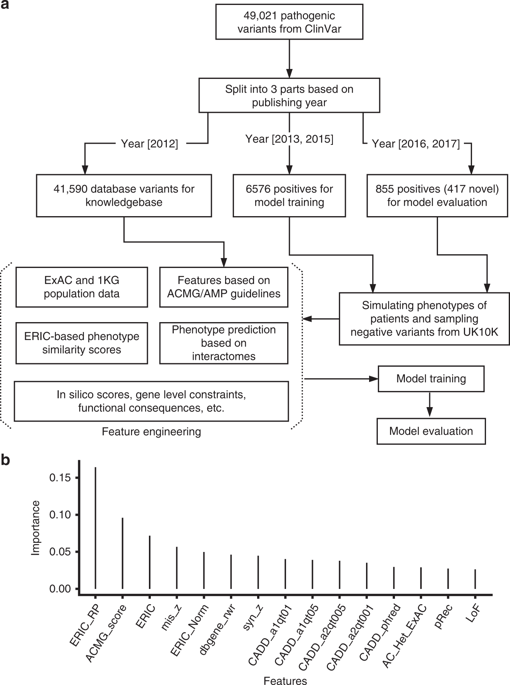当前位置:
X-MOL 学术
›
Genet. Med.
›
论文详情
Our official English website, www.x-mol.net, welcomes your
feedback! (Note: you will need to create a separate account there.)
Xrare: a machine learning method jointly modeling phenotypes and genetic evidence for rare disease diagnosis.
Genetics in Medicine ( IF 6.6 ) Pub Date : 2019-01-24 , DOI: 10.1038/s41436-019-0439-8 Qigang Li 1 , Keyan Zhao 1 , Carlos D Bustamante 2, 3 , Xin Ma 1, 4 , Wing H Wong 3, 4
Genetics in Medicine ( IF 6.6 ) Pub Date : 2019-01-24 , DOI: 10.1038/s41436-019-0439-8 Qigang Li 1 , Keyan Zhao 1 , Carlos D Bustamante 2, 3 , Xin Ma 1, 4 , Wing H Wong 3, 4
Affiliation

|
PURPOSE
Despite the successful progress next-generation sequencing technologies has achieved in diagnosing the genetic cause of rare Mendelian diseases, the current diagnostic rate is still far from satisfactory because of heterogeneity, imprecision, and noise in disease phenotype descriptions and insufficient utilization of expert knowledge in clinical genetics. To overcome these difficulties, we present a novel method called Xrare for the prioritization of causative gene variants in rare disease diagnosis.
METHODS
We propose a new phenotype similarity scoring method called Emission-Reception Information Content (ERIC), which is highly tolerant of noise and imprecision in clinical phenotypes. We utilize medical genetic domain knowledge by designing genetic features implementing American College of Medical Genetics and Genomics (ACMG) guidelines.
RESULTS
ERIC score ranked consistently higher for disease genes than other phenotypic similarity scores in the presence of imprecise and noisy phenotypes. Extensive simulations and real clinical data demonstrated that Xrare outperforms existing alternative methods by 10-40% at various genetic diagnosis scenarios.
CONCLUSION
The Xrare model is learned from a large database of clinical variants, and derives its strength from the tight integration of medical genetics features and phenotypic features similarity scores. Xrare provides the clinical community with a robust and powerful tool for variant prioritization.
中文翻译:

Xrare:一种机器学习方法,联合建模用于罕见病诊断的表型和遗传证据。
目的 尽管新一代测序技术在诊断罕见孟德尔疾病的遗传原因方面取得了成功,但由于疾病表型描述的异质性、不精确性和噪声以及对专家知识的利用不足,目前的诊断率仍远不能令人满意。临床遗传学。为了克服这些困难,我们提出了一种称为 Xrare 的新方法,用于在罕见病诊断中对致病基因变异进行优先排序。方法 我们提出了一种新的表型相似性评分方法,称为发射-接收信息内容 (ERIC),该方法对临床表型中的噪声和不精确具有高度耐受性。我们通过设计实施美国医学遗传学和基因组学学院 (ACMG) 指南的遗传特征来利用医学遗传领域知识。结果 在存在不精确和嘈杂表型的情况下,疾病基因的 ERIC 评分始终高于其他表型相似性评分。广泛的模拟和真实的临床数据表明,在各种基因诊断场景中,Xrare 的性能优于现有的替代方法 10-40%。结论 Xrare 模型是从大型临床变异数据库中学习的,其优势来自医学遗传学特征和表型特征相似性评分的紧密结合。Xrare 为临床社区提供了一个强大而强大的变异优先级工具。广泛的模拟和真实的临床数据表明,在各种基因诊断场景中,Xrare 的性能优于现有的替代方法 10-40%。结论 Xrare 模型是从大型临床变异数据库中学习的,其优势来自医学遗传学特征和表型特征相似性评分的紧密结合。Xrare 为临床社区提供了一个强大而强大的变异优先级工具。广泛的模拟和真实的临床数据表明,在各种基因诊断场景中,Xrare 的性能优于现有的替代方法 10-40%。结论 Xrare 模型是从大型临床变异数据库中学习的,其优势来自医学遗传学特征和表型特征相似性评分的紧密结合。Xrare 为临床社区提供了一个强大而强大的变异优先级工具。
更新日期:2019-01-26
中文翻译:

Xrare:一种机器学习方法,联合建模用于罕见病诊断的表型和遗传证据。
目的 尽管新一代测序技术在诊断罕见孟德尔疾病的遗传原因方面取得了成功,但由于疾病表型描述的异质性、不精确性和噪声以及对专家知识的利用不足,目前的诊断率仍远不能令人满意。临床遗传学。为了克服这些困难,我们提出了一种称为 Xrare 的新方法,用于在罕见病诊断中对致病基因变异进行优先排序。方法 我们提出了一种新的表型相似性评分方法,称为发射-接收信息内容 (ERIC),该方法对临床表型中的噪声和不精确具有高度耐受性。我们通过设计实施美国医学遗传学和基因组学学院 (ACMG) 指南的遗传特征来利用医学遗传领域知识。结果 在存在不精确和嘈杂表型的情况下,疾病基因的 ERIC 评分始终高于其他表型相似性评分。广泛的模拟和真实的临床数据表明,在各种基因诊断场景中,Xrare 的性能优于现有的替代方法 10-40%。结论 Xrare 模型是从大型临床变异数据库中学习的,其优势来自医学遗传学特征和表型特征相似性评分的紧密结合。Xrare 为临床社区提供了一个强大而强大的变异优先级工具。广泛的模拟和真实的临床数据表明,在各种基因诊断场景中,Xrare 的性能优于现有的替代方法 10-40%。结论 Xrare 模型是从大型临床变异数据库中学习的,其优势来自医学遗传学特征和表型特征相似性评分的紧密结合。Xrare 为临床社区提供了一个强大而强大的变异优先级工具。广泛的模拟和真实的临床数据表明,在各种基因诊断场景中,Xrare 的性能优于现有的替代方法 10-40%。结论 Xrare 模型是从大型临床变异数据库中学习的,其优势来自医学遗传学特征和表型特征相似性评分的紧密结合。Xrare 为临床社区提供了一个强大而强大的变异优先级工具。











































 京公网安备 11010802027423号
京公网安备 11010802027423号